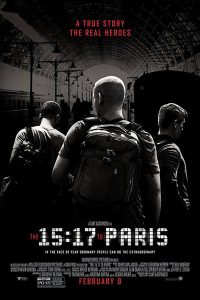REVIEW: The 15:17 to Paris – more like 94-minutes of Hell
“The 15:17 to Paris” is an American drama/thriller film directed by Clint Eastwood and based on the autobiography of “The 15:17 to Paris: The True Story of a Terrorist, a Train, and Three American Soldiers” by Jeffery E. Stern, which was inspired by the true heroic event against terrorism that took place Aug. 21, 2015.
On that day, three childhood friends were abroad the Thalys, a high-speed, Paris-bound train packed with 500 people, when Ayoub El Khazzni, armed with a knife, a pistol and an assault rifle with about 300 rounds of ammunition, opened fire. He was disarmed and stopped by the three friends along with help from various French and British passengers.

The film follows the adventures of Spencer Stone, Anthony Sadler and Alek Skarlatos, who play themselves in the movie. Although the incident occurred within seconds, at 94-minutes, the film is more of the narrative backstory of the three childhood friends and how their lives led up to this heroic act.
After Stone, at the time a 23-year-old Airman First Class in the U.S. Air Force, enlists and completes basic training, he decides to take a trip through Europe with his two best friends, Sadler, a 23-year-old senior at California State University, and Skarlatos, a 22-year-old Army National Guard specialist, before getting stationed abroad.
From a cinematography perspective, the movie was definitely directed by Clint Eastwood. His iconic focus on American culture and history is recognizable by his choices when directing this patriotic story. Eastwood’s classic underdog story shines through as the back-story shows how the three protagonists were bullied as children and ran into behavioral problems.
The idea of using heroes-turned-actors was brilliant but, unfortunately, poorly executed. Even though they cast the real-life heroes, the on-screen relationship between them seemed artificial and awkward. The conversation in the script was stiff, dry and cringe-worthy. This caused the film to seem slow-paced and even boring from time to time.
The antagonist represented any faceless terrorist. He had no description other than what he was wearing that day. The film deliberately showed no backstory to humanize him. No doubt Eastwood’s reason behind this was to not glorify the terrorist acts of Khazzni, but to portray him as the threat he was.
In contrast, the film did show flashbacks of Stone learning the military training he would need to stop the attack, foreshadowing the events to come. The highlight of the film was, not surprisingly, when the terrorist attack occurred because of all the action at play.
The movie ended with the actual footage of the three being awarded for their bravery. The three friends received the Legion of Honor by the former French President Francois Hollande and the Purple Heart award by the former U.S. President Barack Obama.
This real-life story is inspiring, but the movie is not worth seeing. The bravery of the men who risked their lives for others is extremely commendable; perhaps the autobiography would shed more light than the film. As is often the case, the book may be better than the movie.

